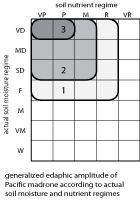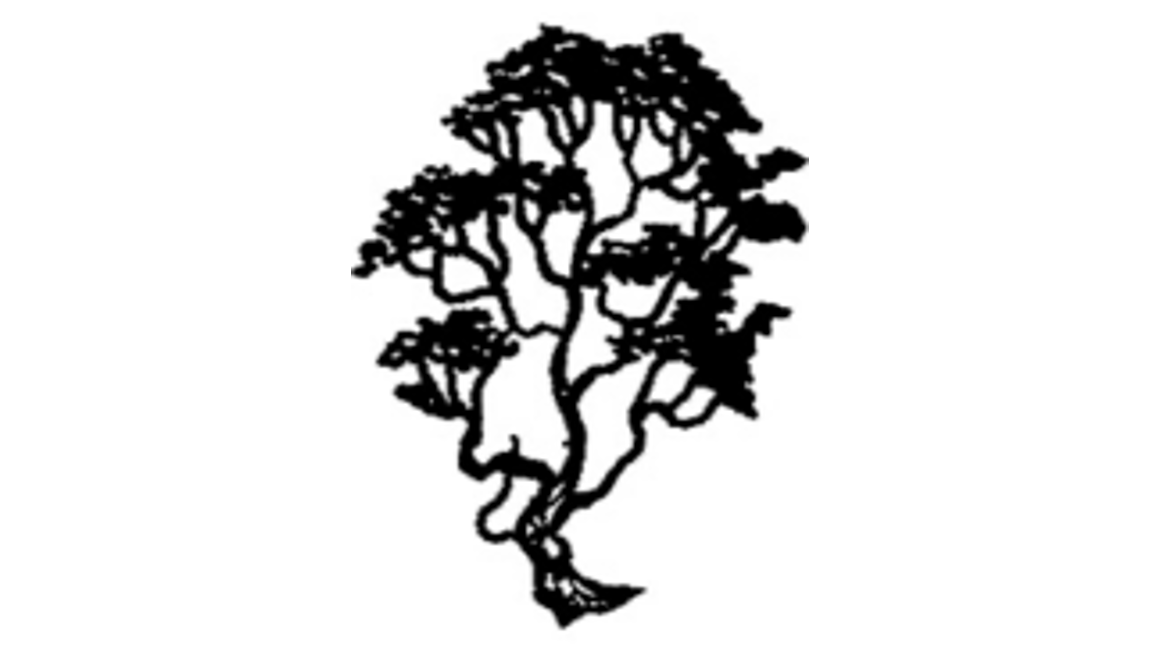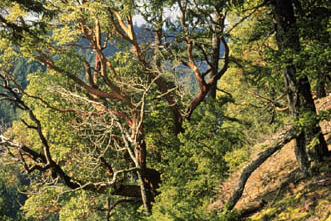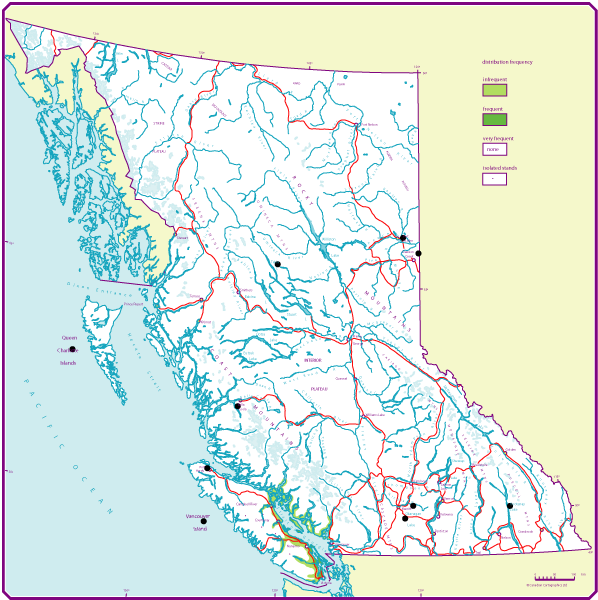Arbutus
On this page
- Geographic range and ecological amplitudes
- Tolerances and damaging agents
- Silvical characteristics
- Genetics and notes
Geographic range and ecological amplitudes
Description
Arbutus, also known as Pacific madrone, is a tall shrub to small or medium-sized (< 30m tall), evergreen broad-leaved tree, at maturity with an irregular, commonly short, umbrella-like shaped crown, leaning and crooked stem, and smooth, thin, reddish-brown bark, peeling in papery flakes and strips in summer to reveal olive green beneath. The bark is scaly at maturity. Pacific madrone is not grown for timber production; its wood utilization potential is very low.
Geographic range
Geographic element:
Western North American/mainly Pacific and less Cordilleran
Distribution in Western North America:
central and south in the Pacific region; (central) and (south) in the Cordilleran region
Ecological amplitudes
Climatic amplitude:
cool and warm mesothermal
Orographic amplitude:
submontane - montane
Occurrence in biogeoclimatic zones:
CDF, (CWH)
Edaphic amplitude:

Range of soil moisture regimes:
very dry - moderately dry - slightly dry - (fresh)
Range of soil nutrient regimes:
very poor - poor - medium - (rich); oxylophytic
On the basis of field studies, Krajina (1969) concluded that the nutritional requirements of Pacific madrone for nitrogen, calcium, magnesium, potassium, and phosphorus are low; no plant indicators of available soil nitrate-N grow in the understory of Pacific madrone-dominated ecosystems.
Tolerances and damaging agents
Root system characteristics
The root system of Pacific madrone exhibits large variations in pattern and length. 50-year-old trees often have a well-developed root burl from which a spreading root system composed of deep-spreading lateral roots develops. Roots are associated with ericoid mycorrhizae.
| Tolerance to | Tolerance class | Comments |
|---|---|---|
| low light | L | high tolerance in the seedling stage |
| frost | L | very sensitive to frost |
| heat | H | tolerates insolated sites |
| water deficit | H | very frequent on water-deficient sites |
| water surplus | L | absent on water-surplus sites |
| nutrient (mainly N) deficiency | H | tolerates acid, leached, very poor soils |
| Damaging agent | Resistance class | Comments |
|---|---|---|
| snow | M | snowpack is infrequent in submaritime cool mesothermal climates |
| wind | M | firmly rooted, even on rock outcrops |
| Risk class | ||
|---|---|---|
| fire | H | a major damaging agent |
| insect | L | not a serious concern |
| fungi | M | not a serious and major concern; leaf spots, leaf rust, tar spot, cankers (madrone canker), root disease |
Associated tree species and successional role
In British Columbia, Pacific madrone grows in small, open to closed-canopy stands or, more often, mixed with common douglas, less often, with lodgepole pine, and rarely with Garry oak, on warm-aspect, water-deficient sites in southwestern coastal B.C., typically on rocky shores. It is often a pioneer species in primary succession on rock outcrops, and is present in early, mid-, and late (old-growth) stages of secondary succession.
Genetics and notes
Genetics
No natural varieties or hybrids of Pacific madrone are known.
Notes
Pacific madrone is the only broad-leaved evergreen tree species of British Columbia. Although not grown commercially for timber production, scattered native trees and stands are valued scenic assets in wildlands, parks, and urban areas with its limited B.C. range. More detailed silvics information is given by:
McDonald, P.M. and J.C. Tappeiner, II. 1990. Arbutus menziesii. Pp. 124-132 in R.M. Burns and B.H. Honkala (technical coordinators) Silvics of North America, Vol. 2. Agri. Handbook 654, USDA For. Serv., Washington, D.C.

This is the general shape and outline of the arbutus.

Arbutus, also known as Pacific madrone, very frequently grows in association with common Douglas-fir on rock outcrops along the shoreline of southern and eastern Vancouver Island, the Sunshine Coast, and the Gulf Islands.

